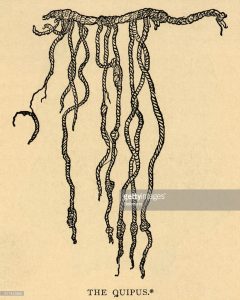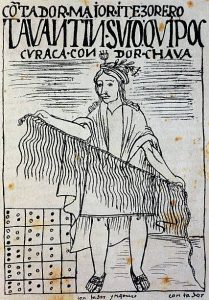
The Quipu was a way the Incas and other Andean cultures kept track of things. It is an arrangement of knotted and colored cotton cords that were used as a devise to keep records and communicate information. To the untutored eye, this bunch of cords arranged on another cord or even on a stick, could pass as a messy mop.
The Inca Empire reached its height in 15th and 16th century Peru. They had the most complex society in the Americas but had no written records. This all crumbled with the invasion of the conquistadores.
In 1532, Spanish conquistadors under Francisco Pizarro first made contact with the mighty Inca Empire which ruled parts of present-day Peru, Ecuador, Chile, Bolivia, and Colombia.
Within 20 years, the Empire was in ruins and the Spanish were in undisputed possession of the Inca cities and wealth: Peru would continue to be one of Spain’s most loyal and profitable colonies for another three hundred years.
The Spanish knew about the quipus but didn’t really understand them. Therefore they burned them as ungodly. In more recent history they were dug out of graves and ended up in museum drawers. Around the end of the 19th century, scientists were realizing the importance of studying them as the last opportunity to save the knowledge encoded on the quipus.
Decoding the quipus has been a challenge. In the mid 20th century, work was done to codify the different colors of strings and types of knots found on the still existing quipus. Researchers always had a general sense of what was encoded on the quipus: census data, calendar systems, and what was collected from towns and villages as taxes or levies.
Just recently a first year Harvard student, Manny Medrano, spent his spring break working with Professor Gary Orton, who is a scholar of Pre-Columbian studies. With the help of a Spanish census document that corresponded with the six quipus he was looking at, and the help of an Excel spreadsheet, Manny Medrano was able to graph and decipher the cords and note that the color of the cords and the way the knots were tied denoted first names of the people and their social status.
The were working with six quipus but this research could serve as the key to decoding others.
Professor Urton and Mr. Medrano find the most exciting part of this breakthrough is the potential to better understand Inca history from the indigenous point of view.
******************
Quipu by Mark Cartwright , published May 8, 2014,
The College Student who Decoded the Data Hidden in the Inca Knots by Katherine Davis-Young Atlas Obscura December 14, 2017
A paper by Marcia and Robert Asher, 1975
Click here for the next article.